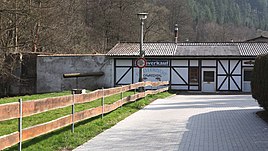Mankenbachsmühle
|
Mankenbachsmühle
Community Unterweißenbach
Coordinates: 50 ° 37 ′ 8 ″ N , 11 ° 9 ′ 21 ″ E
|
|
|---|---|
| Height : | 320 m above sea level NN |
| Postal code : | 07426 |
| Area code : | 036738 |
|
Trout farm
|
|
The place Mankenbachsmühle is a small settlement with mixed development. It belongs to the community of Unterweißbach . In addition to the Mankenbachsmühle, in connection with the construction of the Leibis-Lichte dam, the Neu-Leibis settlement was built for the resettlers of the now flooded Leibis settlement.
location
The entire area is located on the banks of the Schwarza , it is located directly at the confluence of the Lichte and near the confluence of the Mankenbach into the Schwarza. The “Neu-Leibis” settlement was built in the immediate vicinity.
Outside the historical location, a few holiday homes, residential and farm buildings and a fish farm were built in the 1990s. The railway line (Rottenbach - Katzhütte) and the road running parallel to it (L 1112) below the Neuleibis district limit the area to the west.
history
Gold mining
The Mankenbachsmühle was initially a remote mill on the upper reaches of the Schwarza. The first documentary mention dates from the year 1370. With the discovery of gold particles in the Schwarza sediment, mining was also started at the Mankenbach mill. The mining technology was based on the tried and tested gold soap process . The whole valley floor around the mill still shows clear traces of this first mining period, which began in the 15th century. After the Thirty Years War the prospecting for gold was stopped. Before the First World War , the geologist Hess von Wichdorff examined the old mining relics in the upper Schwarzatal and found further mining sites on the slope above the Mankenbachsmühle.
Smelter
Between 1688 and 1758 the mill was rebuilt and now served as a stamping mill for crushing ore. An iron ore smelter was operated next to the mill property. They used the abundant wood stocks and the brownstone ore deposits mined in the nearby mine area in the middle Lichtetal . The princes ruling in the Principality of Schwarzburg-Rudolstadt at that time were interested in expanding mining, and they also allowed the construction of glassworks .
Mass mill for porcelain production
By chance the Mankenbachsmühle played an important role in the discovery of the production technique for soft porcelain , a technological intermediate stage in the early porcelain production. Georg Heinrich Macheleid (1723–1801), a theology student and autodidact who was engaged in practical experiments in porcelain production here and in the neighboring Sitzendorf, needed a mass mill in order to be able to produce the raw materials he tested in the required quality and quantity. The remote Mankenbachsmühle with the still existing grinding and stamping works for ore processing was an ideal place for his experiments. The mass mill supplied the second, built by Macheleid and its affiliates from 1762 Compagnie on the miner's Gutsgelände in Volkstedt in Rudolstadt . This second manufactory had developed into a flourishing company thanks to financial support from the royal family in Schwarzburg, while the Sitzendorf manufactory continued to function as an experimental workshop.
Paper mill
By using water power, part of the Mankenbachsmühle was used again as an ordinary grinding mill from 1764 and later a wood grinding shop was built there. The press grinders, which were driven by two Francis turbines , were crushed, peeled spruce wood fibers, and then ground into wood pulp. This product, also known as wood pulp , was a preliminary product of the paper industry. The unprofitable production led to the cessation of production after the Second World War , the scrapping of the plants and the subsequent decay of the production buildings from the mid-sixties.
Fish farm
From the beginning of the 1970s, the existing mill ditch began to be used for trout fattening in net cages. According to the decision of the state organs at the time, a trout rearing facility / seedling rearing facility was later built on the area. After the fall of the GDR, the facilities and buildings were privatized. The basin is still used as a trout farm, another small business operates an ornamental fish wholesaler.
literature
- Horst Fleischer: Porcelain from Sitzendorf and Volkstedt. Part 1. In: Rudolstädter Heimathefte. Vol. 56, Issue 1/2, 2010, ISSN 0485-5884 , pp. 39-47.
- Markus Schade: Gold in Thuringia. Thuringian Forest, Slate Mountains, Franconian Forest. Origin - formation - localities. Thuringian State Institute for Geology, Weimar 2001, ISBN 3-9806811-3-0 .
Individual evidence
- ^ Rudolf Hundt: Thuringian gold and the history of its mines and extraction. In: Thuringian monthly sheets. Vol. 24, No. 7, 1916/1917, ZDB -ID 527359-6 , 83-86 .
- ↑ Günter Dörfel: Soft porcelain from Volkstedt - does Macheleit's porcelain invention have to be re-dated? For the reinvention of European porcelain in Thuringia 250 years ago. In: Sheets of the Association for Thuringian History. 19, 2009, ISSN 2194-3966 , pp. 11-19.
